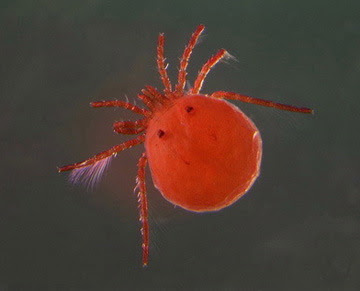Belongs within: Neohydrachnidia.
Hydrachna is a cosmopolitan genus of water mites found in temporary pools, ponds and lakes; larvae are parasitic on Hemiptera and Coleoptera (Walter et al. 2009). Eggs are laid in the stalks of aquatic plants with females using their ovipositor to push eggs into internal air spaces (Walter & Proctor 1999). Larvae remain much of the year in diapause attached to their hosts while the vernal pools in which the adults breed are dry (Walter et al. 2009).
Characters (from Walter et al. 2009): Adult gnathosoma typically with long, curved, pointed rostrum. Palpi chelate, with dorsodistal tibial claw extending well beyond base of tarsus; genu longer than tibia. Chelicerae one-segmented and styletiform. Idiosoma with lateral eye capsules present and not borne on dorsal plate; body nearly spherical, variable in degree of sclerotisation, ranging from soft with dorsum bearing only glandularia platelets to heavily armoured with dorsum entirely covered by a dorsal shield. Genital field heart-shaped in males and rounded in females, with gonopore located posteriorly; bearing numerous genital acetabula borne on plates flanking gonopore; with conspicuous tubular ovipositor in females. Larvae aquatic. Gnathosoma lacking elaborate camerostome. Idiosoma with lateral eyes borne on dorsal plate; dorsum with large dorsal plate bearing eight pairs of setae, including verticils, scapulars, c3, and three additional pairs of hysterosomatic setae. Venter with coxal plates all separate; with paired urstigmata laterally between coxal plates I–II; coxal plates III located near midlength of body and laterally directed; excretory pore plate lacking setae. Leg with five movable segments, with basifemur and telofemur fused; tarsus with claws absent but empodium present.
<==Hydrachna Müller 1776 RFF05
|--H. (Anohydrachna) maramauensis Stout 1953 SL71
|--H. (Diplohydrachna Thor 1916) RFF05
| `--H. (D.) chilensis Gervais 1849 RFF05
|--H. (Rhabdohydrachna Viets 1931) RFF05
| |--H. (R.) rectirostris Viets 1940 RFF05
| `--H. (R.) silvestrii Ribaga 1902 RFF05
`--H. (Scutohydrachna Viets 1933) RFF05
|--H. (S.) miliaria Berlese 1888 RFF05
| |--H. m. miliaria RFF05
| `--H. m. constricta Lundblad 1941 RFF05
|--H. (S.) nonlamellata Viets 1940 RFF05
`--H. (S.) portigera Lundblad 1941 RFF05
Hydrachna incertae sedis:
H. agilis Gervais 1849 RFF05
H. approximata Halik 1940 H98
H. australica Lundblad 1941 H98
H. bilobata Halik 1940 [incl. H. laceriscuta Lundblad 1941] H98
H. conjecta Koenike 1895 D91
H. conjectoides Lundblad 1947 H98
H. cruenta WWO01
H. cyanipes Lucas 1847 E12
H. erythrina Lucas 1847 E12
H. fuscata WP99
H. geographica MK91
H. globosa D01
H. hamata Lundblad 1947 H98
H. heterophthalma Viets 1954 RFF05
H. inermis Daday 1901 D01
H. linderi Lundblad 1947 H98
H. magniscutata WL09
H. odontognatha Canestrini 1884 [=H. odontognathus] H98
H. palustris Smit 1992 H98
H. pusilla Daday 1905 RFF05
H. rossica Daday 1901 D01
H. rostrata Lucas 1847 E12
H. simulans Marshall 1928 [=Hydrarachna (l. c.) simulans] H98
H. tasmanica Lundblad 1947 H98
H. testudinata WL09
H. tomentosa Lucas 1847 E12
H. triscutata Lundblad 1947 H98
H. ventrifissa Viets 1954 RFF05
H. virella Lanciani 1979 D91
*Type species of generic name indicated
REFERENCES
[D01] Daday, E. 1901. Édesvizi mikroszkópi állatok [Mikroskopische Süsswasserthiere]. In: Horváth, G. (ed.) Zichy Jenő Gróf Harmadik Ázsiai Utazása [Dritte Asiatische Forschungsreise des Grafen Eugen Zichy] vol. 2. Zichy Jenő Gróf Harmadik Ázsiai Utazásának Állattani Eredményei [Zoologische Ergebnisse der Dritten Asiatischen Forschungsreise des Grafen Eugen Zichy] pp. 375–470. Victor Hornyánszky: Budapest, and Karl W. Hierseman: Leipzig.
[D91] Davids, C. 1991. Water mites: the impact of larvae and adults on their host and prey populations. In: Dusbábek, F., & V. Bukva (eds) Modern Acarology: Proceedings of the VIII International Congress of Acarology, held in České Budĕjovice, Czechoslovakia, 6–11 August 1990 vol. 1 pp. 497–501. SPB Academic Publishing: The Hague.
[E12] Evenhuis, N. L. 2012. Publication and dating of the Exploration Scientifique de l'Algérie: Histoire Naturelle des Animaux Articulés (1846–1849) by Pierre Hippolyte Lucas. Zootaxa 3448: 1–61.
[H98] Halliday, R. B. 1998. Mites of Australia: A checklist and bibliography. CSIRO Publishing: Collingwood.
[MK91] Meyer, E., & K. Kabbe. 1991. Pigmentation in water mites of the general Limnochares Latr. and Hydrodroma Koch (Hydrachnidia). In: Schuster, R., & P. W. Murphy (eds) The Acari: Reproduction, development and life-history strategies pp. 379–391. Chapman & Hall: London.
[RFF05] Rosso de Ferradás, B., & H. R. Fernández. 2005. Elenco y biogeografía de los ácaros acuáticos (Acari, Parasitengona, Hydrachnidia) de Sudamérica. Graellsia 61 (2): 181–224.
[SL71] Spain, A. V., & M. Luxton. 1971. Catalog and bibliography of the Acari of the New Zealand subregion. Pacific Insects Monograph 25: 179–226.
[WL09] Walter, D. E., E. E. Lindquist, I. M. Smith, D. R. Cook & G. W. Krantz. 2009. Order Trombidiformes. In: Krantz, G. W., & D. E. Walter (eds) A Manual of Acarology 3rd ed. pp. 233–420. Texas Tech University Press.
[WP99] Walter, D. E., & H. C. Proctor. 1999. Mites: Ecology, Evolution and Behaviour. CABI Publishing: Wallingford (UK).
[WWO01] Wohltmann, A., H. Witte & R. Olomski. 2001. Organismal patterns causing high potential for adaptive radiation in Parasitengonae (Acari: Prostigmata). In: Halliday, R. B., D. E. Walter, H. C. Proctor, R. A. Norton & M. J. Colloff (eds) Acarology: Proceedings of the 10th International Congress pp. 83–99. CSIRO Publishing: Melbourne.
Last updated: 11 July 2022.

No comments:
Post a Comment
Markup Key:
- <b>bold</b> = bold
- <i>italic</i> = italic
- <a href="http://www.fieldofscience.com/">FoS</a> = FoS